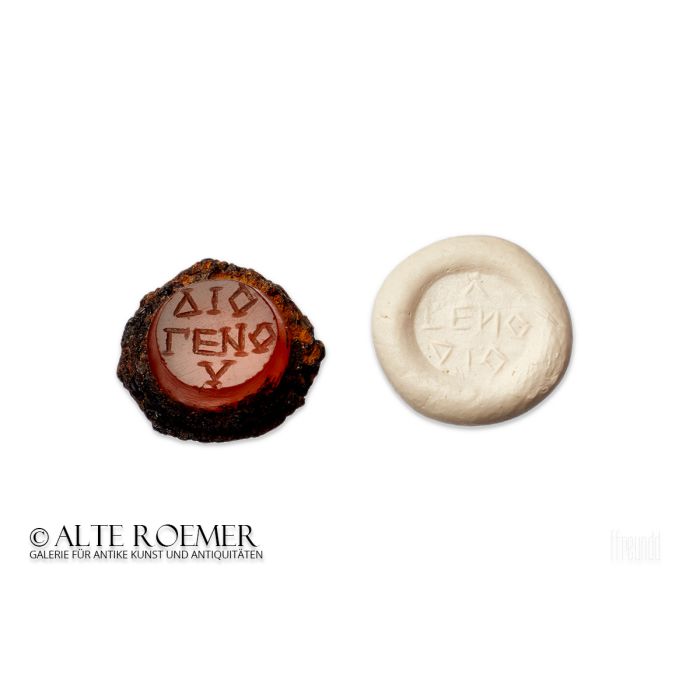Roman intaglio inscribed DIOGENOY
Price: on request
Sold
Object number
AR1951-005
| Object: |
Roman intaglio with rest of a ring
|
| Material: |
Red clear carnelian. Remains of the ring made of iron.
|
| Period: |
3rd century AD. Roman Imperial. |
| Description: |
Roman intaglio with the original iron ring around it, only the part around the gem stone preserved. The inscription reads "DIOGENOY". Interestingly it is legible on the stone itself, not on its imprint.
|
| Dimensions: |
8mm diameter of the stone, 12mm length of the ring fragment.
|
| Condition: |
Stone perfectly preserved and legible. Some remains of the iron ring still present.
|
| Provenance: |
From the German collection of Professor H. Brosch (1923 to 2009), author of historical publications, scientific museum advisor, decorated by the Order of Merit of the Federal Republic of Germany. The collection was built between 1960 and 1975. It was inherited to U. Buechner, Germany, and then acquired by us in 2013.
The Professor Brosch collection of ancient Gems: After the decline of the Roman Empire, ancient gems retained or regained recognition in medieval Europe. In addition to frequent reuse in church art, there were also profane uses. This is shown by the example of the ancient intaglio of Julia, daughter of Emperor Titus. It was reused in the 9th century by the Merovingians in the "Escrain de Charlemagne" and can be admired today in the French National Library. The reception of ancient glyptic during the Italian Renaissance resulted in a great fashion to collect gems, which could be entertained by the European educated bourgeoisie during journeys through the Mediterranean in the spirit of enlightenment and education. Thus Goethe, inspired by his trip to Italy, which was immortalised in literature, also built up a collection of antiquities. The collection of ancient intaglios by Professor Brosch is certainly a late classicist continuation of this tradition. The collection forms a systematic cross-section of the thematic diversity of ancient gems and has been worked on extensively with a scholarly approach. Professor Brosch had a great interest, not only in ancient history, but also in the more recent history of his home region. He was honoured with the Federal Cross of Merit for his achievements in the field of historical studies. It is with pride that we have fully documented this collection and provided it with literature references. We are now pleased to bring these miniature works of art from the ancient world back into circulation and to enrich a collection in the tradition of the Renaissance and Enlightenment in a worthy manner. If you are interested in purchasing the collection in its entirety, please do not hesitate to contact us. |
| Literature: |
The classic and main work on the art of ancient engraved seals is A. Furtwaengler, Die antiken Gemmen, Volumes 1 to 3 (Leipzig and Berlin, 1900). A compact introduction and a cross-section of motifs is offered by G. Lippold in Gemmen und Kameen des Altertums und der Neuzeit (Stuttgart, 1921). Our recommendation for budding collectors is H. Gebhart, Gemmen und Kameen (Berlin, 1925). The book is well available in antiquarian bookshops. It provides a very good introduction to the materials used and then goes through the entire history of glyptic with numerous, well-explained examples. |
| Authenticity: |
We unconditionally guarantee the authenticity of every artefact, all items are subject to our lifetime return policy on authenticity.
|


